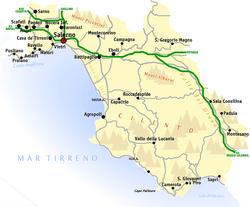Salerno Ivories
The Salerno Ivories (also known as Amalfi) are a collection of biblical ivory plaques from the 11th or 12th century and are Byzantine in origin. The majority of the plaques are housed in the Diocesan Museum of the Cathedral of Salerno, which is where the group's main namesake comes from.[1] There are identified ivory workshops in Salerno and Amalfi, with both being proposed as the place of origin for the ivory group (and resulting in the interchangeable names), but neither has been definitively linked to the plaques so the city of origin remains unknown.[2][3] Smaller groups of the plaques are currently housed in different museum collections in Europe and America.[2]
The plaques make up one part of a broad group of ivory artifacts from the same eras and region of southern Italy. These consist of collections of objects such as: Oliphants, bone-and-ivory boxes, chess pieces, Siculo-Arabic boxes, Italo-Byzantine ivories and the Farfa Casket.[2]
Details

The Salerno Ivories are a collection of over 70 plaques that depict scenes from the New and Old Testaments.[4] They are carved in relief into flat segments of ivory with artistic influences from early Christian, Italian, Islamic and Byzantine styles.[2][5] The plaques vary in size. The Old Testament sequence are 12 cm to 24 cm wide and about 9 cm tall, while many of the New Testament plaques range from 24 cm tall and 12 cm wide.[1] Cornices and borders average from 21–25 cm long by about 7 cm wide.[6] The colonettes are about 23 cm x 2 cm and the busts are 6 cm squared.[6]
Each plaque is carved in high relief, with figures, objects and animals in the scene appearing to come out of the ivory panel. Some of the different figures have glass eyes still intact in colors like blue, black or red.[7] Each scene is bordered around the edges of the ivory and the entire series has detached decorative cornices, borders and colonnettes.[7] The cornices and borders contain inhabited scrolls, plants and cornucopias, while the colonnettes contain a decorative twisting column. There are also small square-and-circle bust portraits of different Apostles and Donors.[7]
The original sequence and arrangement for the ivories are unknown.[8] Scholars have proposed the plaques were part of a throne, casket or door, but no evidence has been found to support this.[9] The only documentation discussing an arrangement for the plaques was in 1623 at the death of Lucio Sanseverino, the then Archbishop of the Salerno Cathedral where he requested them hung on an altar.[8]
The first known documentation of the ivories was in 1510 in a chapel behind the Salerno Cathedral.[8] The Ivories are understood as Christian religious works, but some scholars have also proposed they held a political significance as well.[10] Since there are no concrete facts to support this, just theories and observations, the truth of the ivories' purpose remains unknown.[10] The patron, agreed by scholars to have been someone of significance to have been able to commission the plaques, is also unknown.[9]
 God Creating the Animals Plaque
God Creating the Animals Plaque The Dormition of the Virgin Plaque
The Dormition of the Virgin Plaque Example of an ivory Oliphant
Example of an ivory Oliphant
References
- 1 2 Bergman, Robert P. The Salerno Ivories : Ars Sacra from Medieval Amalfi. Cambridge, Mass.: Harvard University Press, pgs.1-2, 1980.
- 1 2 3 4 Eastmond, The Salerno Ivories: Objects, Histories, Contexts. Berlin: Gebr. Mann Verlag, pgs.99, 97-109, 103-106 , 2016.
- ↑ Bergman, Robert P. “A School of Romanesque Ivory Carving in Amalfi.” Metropolitan Museum Journal, vol. 9, pg. 183, 1974, web.
- ↑ Blessing and Carile. The Salerno Ivories: Objects, Histories, Contexts. Berlin: Gebr. Mann Verlag, pg. 112, 2016.
- ↑ Wixom, William D. "Eleven Additions to the Medieval Collection." The Bulletin of the Cleveland Museum of Art 66, no. 3, pg. 87-9, 1979.
- 1 2 Kunsthistorisches Institut, Max-Planck-Institut, Iparmüvészeti Múzeum, The Metropolitan Museum, Francesca Dell’Acqua, Foto Scala, Firenze/bpk, Bildagentur für Kunst, Kultur und Geschichte, Museum für Kunst and Gewerbe, pg. 329-38, 339-354. The Salerno Ivories: Objects, Histories, Contexts. Berlin: Gebr. Mann Verlag, 2015.
- 1 2 3 Museo Diocesano The Salerno Ivories: Objects, Histories, Contexts. Berlin: Gebr. Mann Verlag, pgs. 28-54, 355; 2015.
- 1 2 3 Dell’Acqua, Francesca. The Salerno Ivories: Objects, Histories, Contexts. Berlin: Gebr. Mann Verlag, pg. 211, 2016.
- 1 2 Corey, Elizabeth C. "The Two Great Lights: Regnum And Sacerdotium In The Salerno Ivories." History of Political Thought 34, no. 1, pg. 3, 2013.
- 1 2 Corey, Elizabeth C. "The Purposeful Patron: Political Covenant In The Salerno Ivories." Viator: Medieval And Renaissance Studies, Vol 40, No 2, pg. 55, 2009.